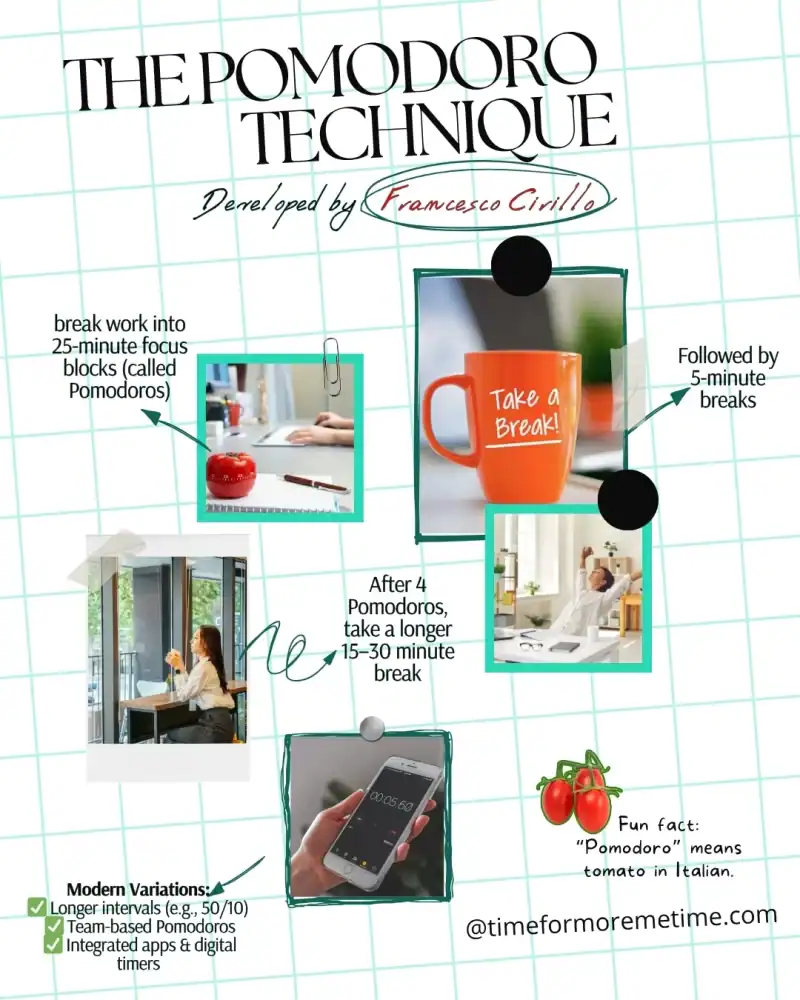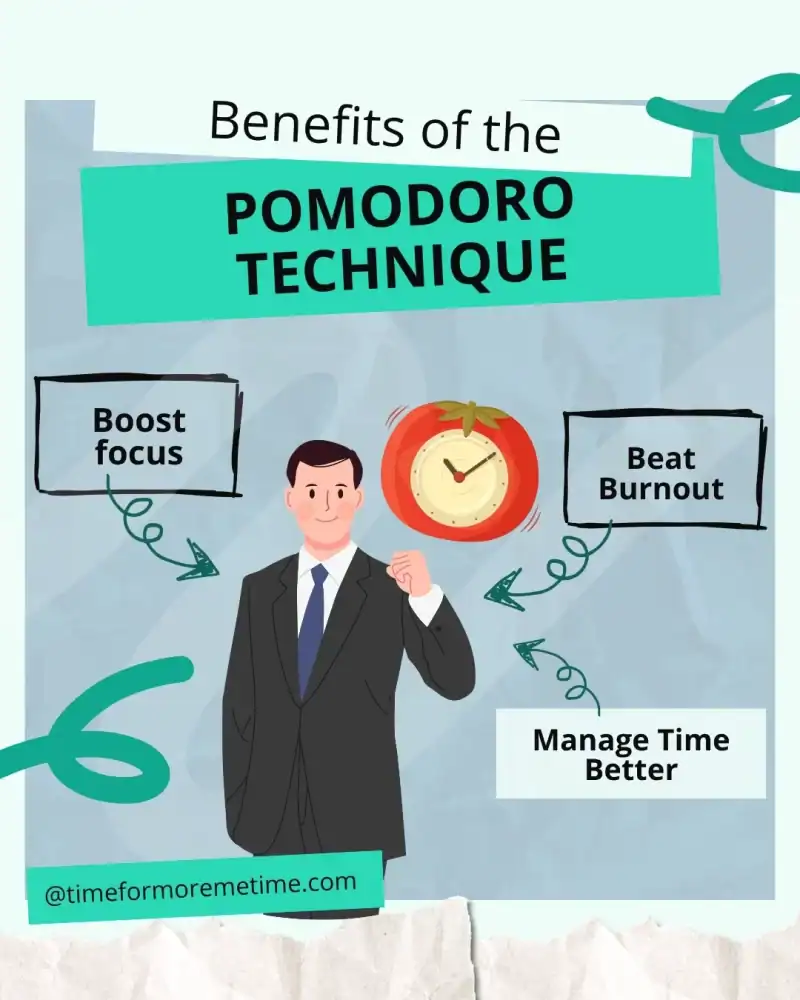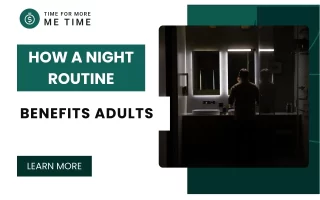If you’ve ever sat down to work and suddenly realized an hour’s gone by with little to show for it, you’re not alone. In this post, I’ll introduce you to the Pomodoro Technique—a simple, timer-based method that helps you stay focused, take purposeful breaks, and actually finish what you start. Let’s get started!
What Is The Pomodoro Technique

The Pomodoro Technique, developed by Francesco Cirillo in the late 1980s, is a straightforward yet effective method for managing time and maintaining focus. The idea is to break your work into 25-minute focused intervals, called Pomodoros, followed by short 5-minute breaks.
Fun fact: Pomodoro is the Italian word for tomato. Francesco Cirillo was inspired to create the Pomodoro Technique using a kitchen timer that was shaped like a tomato.
Since its introduction, many productivity coaches and time management experts have customized the Pomodoro Technique to suit different work styles, goals, and attention spans. You might come across versions with longer intervals, collaborative Pomodoros, or ones blended with digital tools and apps.
For this post, we’ll stick with the traditional Pomodoro format while offering tips to adapt it to your personal routine.
At its core, the Pomodoro Technique is about building deep focus in short bursts, reducing mental fatigue, and creating a rhythm of work and rest that boosts both productivity and well-being. It’s a great tool for anyone who struggles with procrastination, multitasking, or burnout from long hours of unfocused effort.
Why Should You Use The Pomodoro Technique

The Pomodoro Technique creates structure in your day, making it ideal for people who get distracted easily or feel overwhelmed by long to-do lists. It breaks your time into short, focused intervals that are easier to commit to than hour-long work sessions.
This method can boost productivity by encouraging full concentration during each Pomodoro while reducing burnout through regular breaks. The short bursts of effort also help improve your ability to estimate how long tasks take—an essential skill for better time management.
For larger projects, the technique makes it easier to get started. If a task feels too big, just commit to one Pomodoro. That 25-minute session often builds momentum, making it easier to continue working without feeling drained.
How To Start Using The Pomodoro Technique
You can start using the Pomodoro Technique with just a timer and a task in mind. Here are common ways to apply it in daily life:
- At Work: Use a Pomodoro to focus on writing reports, answering emails, or handling customer queries without multitasking.
- At Home: Set a 25-minute Pomodoro to clean, cook, or declutter a space—one task at a time.
- While Studying: Read a chapter, review notes, or solve problems with full focus for one Pomodoro.
- During Creative Work: Use a Pomodoro to write, draw, or brainstorm ideas without interruption.
- With Breaks: Treat the 5-minute breaks as a chance to stretch, hydrate, or rest your eyes before starting the next Pomodoro.
The technique is built for flexibility—you can adjust the intervals to suit your energy level or task type. The key is to commit fully during each Pomodoro and treat the breaks as non-negotiable resets. Over time, this method helps build better focus and time discipline.
What Are The Drawbacks Of The Pomodoro Technique
While the Pomodoro Technique is widely praised, it’s not without challenges—especially for those new to structured time management. Here are the key drawbacks:
- Interrupting Deep Work: The 25-minute timer can disrupt deep concentration, especially if you’re fully immersed in a task when the alarm rings. Creative or analytical work often needs longer focus periods.
- Feeling Pressured by the Timer: Some people may find the ticking clock stressful rather than motivating, especially if they associate time limits with performance anxiety.
- Rigidity Doesn’t Always Fit: Not every task fits neatly into a 25-minute window. Tasks that take 5 or 40 minutes might feel awkward to split or force into Pomodoro blocks.
- Challenging in Collaborative Settings: In jobs with frequent meetings, calls, or interruptions, following strict Pomodoro intervals may not be realistic or sustainable.
- Breaks Becoming Distractions: Short breaks can accidentally extend into long distractions if you’re not careful—especially when you use that time to scroll on your phone or check social media.
Understanding these drawbacks allows you to adjust the method to your needs—whether that means modifying the timer, skipping the break occasionally, or combining Pomodoros for bigger tasks. Flexibility is key to making it work for you.
Conclusion
The Pomodoro Technique is a simple yet powerful way to stay focused, manage your energy, and make steady progress on your tasks. By working in short bursts with regular breaks, you can avoid burnout, improve concentration, and get more done in less time. It’s a great time management tool for beginners because it’s easy to follow and flexible enough to fit most routines.
To get more helpful tips, subscribe to our blog, follow us on social media, and check out our YouTube channel for cool and insightful videos.
Sources
- Photos: Unsplash: Ngo Ngoc Khai Huyen





